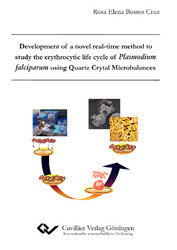| Departments | |
|---|---|
| Book Series (96) |
1378
|
| Nachhaltigkeit |
3
|
| Gesundheitswesen |
1
|
| Humanities |
2365
|
| Natural Sciences |
5406
|
| Mathematics | 229 |
| Informatics | 319 |
| Physics | 980 |
| Chemistry | 1363 |
| Geosciences | 131 |
| Human medicine | 243 |
| Stomatology | 10 |
| Veterinary medicine | 108 |
| Pharmacy | 147 |
| Biology | 835 |
| Biochemistry, molecular biology, gene technology | 121 |
| Biophysics | 25 |
| Domestic and nutritional science | 45 |
| Agricultural science | 1004 |
| Forest science | 201 |
| Horticultural science | 20 |
| Environmental research, ecology and landscape conservation | 148 |
| Engineering |
1793
|
| Common |
98
|
|
Leitlinien Unfallchirurgie
5. Auflage bestellen |
|
Advanced Search
Development of a novel real-time method to study the erythrocytic life cycle of Plasmodium falciparum using Quartz Crystal Microbalances (English shop)
Entwicklung einer neuen Echtzeit-Methode zur Untersuchung des erytrozytärer Lebenszyklus von Plasmodium falciparum mit Schwingquarzbiosensoren
Rosa Elena Bustos Cruz (Author)Preview
Table of Contents, Datei (68 KB)
Extract, Datei (380 KB)
Previous studies carried out by the Biosensor Research Group of the Institute of Clinical
and Experimental Transfusion Medicine at the Tübingen University had successfully
demonstrated determination of various blood types through the interaction of
erythrocytes with immobilised antibodies on a QCM. These studies have opened the
possibility to test new applications of this technique for the study of infectious diseases.
In our case, studies of the erythrocyte life cycle of P. falciparum, particularly during the last
six hours preceding the merozoite release and studies related to reinfection of by
merozoites were the focus of our investigation.
Release of malaria parasites of P. falciparum from infected erythrocyte at the end of their
asexual erythrocyte cycle occurs approximately every 48 hours, asynchronously in parasite
culture and synchronously in vivo. This process is poorly studied due to: (I) merozoite
release is a very short event (<60 S), (II) schizont stages have high sensitivity for culture
conditions like pH, medium, osmotic pressure, gas atmosphere and temperature. (III)
Schizont conditions are not easy to maintain under the miscrocope, making
miscroscopical real time observation of the release difficult.
The aim of the presented project was to study the release of Plasmodium falciparum
merozoites from erythrocytes with the QCM sensor technique. In this way, the frequency
shift due to the change of mass associated to the merozoite release and, on a second
QCM, the reinfection of healthy erythrocytes are monitored in real time. Our QCM
experiments included the following stages: (I) Adaptation and optimisation of the
immobilisation of biological layers to capture the erythrocytes on the quartz. (II)
Optimisation of parasite culture conditions in a QCM chamber. (III) Observation of the
frequency signal both for infected and non-infected erythrocytes samples and correlation
of the signal with the release of merozoites. (IV) Reinfection of healthy erythrocytes on a
second quartz within one QCM system. (V) Test of inhibition of merozoite release and
reinfection by antimalarial compounds.
The results showed that there was significant increase of ~1000 Hz for QCM with
infected erythrocyte compared to QCM with healthy erythrocytes, where the frequency
remained stable. Microscopical observation of the quartz surface at different times during
the experiment (TEM and optical) demonstrated a correlation between the increase in
frequency and merozoite release. At this point, approximately more than 80% of the
infected erythrocytes on the quartz are involved in the release. Reinfection of new
erythrocytes was observed on a second QCM. pH of the system (7.2), Temperature
(37°C+/-0.1), flow of the medium (9 µL/min), sterility of the process (BactAlert), gas
atmosphere (O2 5%, residual N2) were established to ensure parasite development and
survival. External controls using flow cytometry 24 hours after the reinfection show a
parasitemia percentage of >1% in the erythrocytes infected in situ.
Our results show, that the QCM technique is an appropriate and important new tool to
elucidate the biology of the re-invasion process of Plasmodia.
| ISBN-13 (Printausgabe) | 3869552808 |
| ISBN-13 (Hard Copy) | 9783869552804 |
| ISBN-13 (eBook) | 9783736932807 |
| Final Book Format | A5 |
| Language | English |
| Page Number | 158 |
| Lamination of Cover | matt |
| Edition | 1 Aufl. |
| Volume | 0 |
| Publication Place | Göttingen |
| Place of Dissertation | Universität Tübingen |
| Publication Date | 2010-04-15 |
| General Categorization | Dissertation |
| Departments |
Chemistry
Human medicine Pharmacy |








